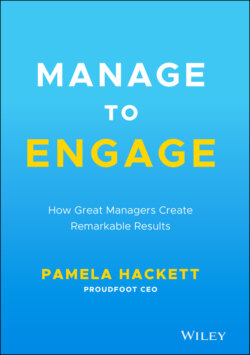Читать книгу Manage to Engage - Pamela Hackett - Страница 43
Clean and Meaningful, Not Lean and Mean
ОглавлениеGone are the days of a strictly ordered workplace where a productive and efficient workforce clocked in, did what they were paid to do, and clocked out again. This low baseline had all but vanished years ago. Fast forward to the COVID-19 pandemic, and we saw whole teams rise up to challenging times, to change needing implementation overnight. They proved they could do it. Those underengaged people whom many managers believed were change resistant or fatigued made a world of difference. The danger is, of course, that the businesses will revert to type. They will fall back into the slow-move world. But where's the incentive to keep the new world and not slip back? We must create one.
Engaged people will willingly lead their companies out of economic holes. They will innovate and create. Engaged people will be at the finish line (if such a place exists); they will also have the reward of working for a fit and healthy business, even a happy one.
Sadly, most businesses have been far from this ideal: the environment they fostered does not inspire people to innovate and help inspire the future. One must ask the question, did the quest for productivity cost us the hearts and minds of our people? The survey results reflect an astounding yes. That could cost companies a great deal more than just the loss of their soul.
Consider a trip down the corporate history lane with the well-known story of 3M. If you were in business at the birth of the Post-It note, you might remember 3M as a business built on novel ideas. But that wasn't the case when James McNerney took the helm in 2001. While the former General Motors executive was able to rejuvenate 3M's share price, it's widely believed that he failed to reenergize its people. After a transformation program built on downsizing and efficiency gains, innovation had all but come to a standstill. It was only after George Buckley replaced McNerney in 2005 and reestablished people as the key drivers of success that it began to report record results once again. The contrast is stark: people as part of a systemic, process-driven culture versus people as the force of a culture that respects the use of processes but isn't a slave to them. In the latter case, the organizational infrastructure works for people, freeing them up to be remarkable – and creating a human competitive edge. This is just a great baseline example of a business that has now lasted the long tail and survived the ups and downs of another decade and a half. It's this leg work years ago that provide for the stories of corporate longevity.
Of course, today everybody talks about Google's 20 percent time, allowing people to work on their own ideas. But it doesn't have to be this big. It can be day-to-day actions, within the day-to-day role of people, that can bring about remarkable changes in results.
